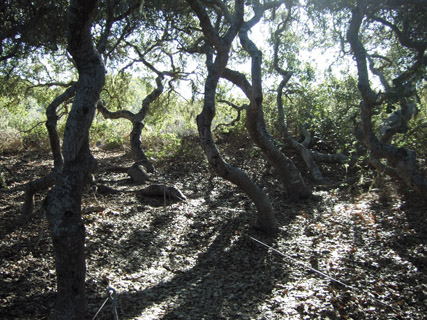Naturally
How best to explain nature
California lays claim to such an embarrassment of wonders that
several lifetimes might hardly scratch the surface.
It was while on a quick trip to San Luis Obispo last weekend
that we were reminded of that yet again.
Naturally
How best to explain nature
California lays claim to such an embarrassment of wonders that several lifetimes might hardly scratch the surface.
It was while on a quick trip to San Luis Obispo last weekend that we were reminded of that yet again.
Ostensibly we were there to visit the elder daughter, but the schedule allowed for some exploration and time to stare at birds.
We had visited the Los Osos Oaks Preserve before. The small park (90 acres) is just off Los Osos Valley Road, west of San Luis Obispo. Located on ancient sand dunes and subject to the salty fog of the coast, the grove of coast live oaks is stunted. Trees 600 to 800 years old creep along the ground, the most inviting climbing trees I’ve ever seen.
But with the state parks’ “no dogs” policy, we went looking elsewhere last weekend.
Nearby, Mary and I blundered into the Elfin Forest preserve, a regional park the same size as its nearby cousin, but with even smaller oaks. A boardwalk meanders through it, making it accessible to anyone, and it welcomes dogs as well.
Sign us up.
As we entered from the end of a quiet residential street, a California thrasher – cousin to the northern mockingbird – showed off from the top of a snag. As we stepped onto the boardwalk, a singular landscape presented itself. Densely wooded, the area swept down to the tidal flats of the Morro Bay Estuary. Ceanothus, sticky monkey, sage, artemisia, bracken fern and a host of other plants elbowed for space in the sand, topped everywhere by tiny oaks. Most stood no more than head high, but the helpful interpretive signs told us the oaks were 100 or more years old.
Everywhere, birds sang from deep in the brush, and animals rustled about. We could stand in the Lilliputian woodland and survey Morro Rock and the bay in front of it – a remarkable mix of habitats if ever there was one.
Soon, we encountered the first in a series of interpretive signs. The colorful fiberglass panel purported to tell the story of a Chumash girl, and how she greeted the landscape in daily life. Looking at the sign long enough to read the story of this fictional native American left me wondering again at how anyone works up the courage to write the interpretive displays that most of us take for granted at parks and museums.
The intent was noble, but in reading about this fictional child, I was immediately reminded of “children’s” radio programs. There’s one on a nearby public radio station each Saturday that features the treacle-voiced narration of what sounds to be an elderly lady. It’s the kind of programming that would send nearly any adult running from the room with hands over the ears, and any child reaching for the nearest Game Boy.
In short, the program and the signs purport to communicate with children by talking down to them.
As I wandered, the signage got me thinking about what a challenge interpretation of what lies displayed right in front of people can be.
I thought back to a day some years ago, when I led a small group around Elkhorn Slough, as I did then regularly.
Our training included more than I thought necessary about how to prevent facts without coloring them with our own preconceptions. I thought I’d already gotten that lesson pretty well in journalism school.
But one of the people training us told a story of leading a large group of people through a landscape, talking of ice ages and prehistoric epochs. He was curious when people in the group giggled nervously, or whispered to one another at inopportune moments.
At the end of the outing, one of the participants was kind enough to explain: “You see, we’re part of a church group, and we believe in Biblical creation, not all that evolution stuff.”
Oh.
Forever after, I’ve been careful to couch nearly every statement in “I wonder,” or “many scientists believe,” or “it’s currently thought to be …”
Sure enough, some years later I received a small package several days after a walk. In it was a thank-you note and a religious tract. The sender thanked me for not ignoring their very fundamentalist view.
And I think that’s the best way to “interpret” the world around us – just the facts, ma’am. The best kids’ radio I have ever heard didn’t pretend to stoop to the height of a 4-year-old. “Rabbit Ears Radio” with Daniel Pinkwater aired each week with well-read tales that left all of us mute. One of my favorite photos is one of a much-smaller-than-now younger daughter lying prone on sun-warmed concrete, radio near her, listening to Mr. Pinkwater tell another story.
There was nary a fictional Chumash girl to be seen.










